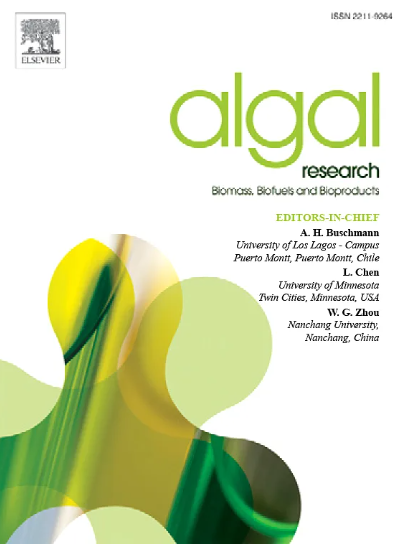Quantification of phytoplankton groups using in-situ multi-excitation chlorophyll fluorescence measurements and machine learning (mf-ML)
IF 4.5
2区 生物学
Q1 BIOTECHNOLOGY & APPLIED MICROBIOLOGY
Algal Research-Biomass Biofuels and Bioproducts
Pub Date : 2025-06-18
DOI:10.1016/j.algal.2025.104155
引用次数: 0
Abstract
This study introduces a novel framework for the high-resolution quantification of phytoplankton communities using machine learning, integrating in situ multi-excitation chlorophyll fluorescence data with traditional high-performance liquid chromatography (HPLC) methods. The framework overcomes limitations of conventional sampling techniques by providing continuous, high-resolution profiling of phytoplankton distributions, capturing diel vertical migration (DVM) patterns, and analyzing responses to environmental factors such as irradiance and nutrient concentrations. The results from an XGBoost (Extreme Gradient Boosting)-based model demonstrated strong predictive accuracy across eight phytoplankton groups, effectively identifying complex nonlinear interactions that traditional methods struggle to resolve. Specifically, the model successfully traced DVM in dinoflagellates, offering insights into harmful algal bloom (HAB) dynamics. This study highlights multi-wave length excited fluorescence spectrometry as a cost-effective, accurate, and robust tool for monitoring phytoplankton distributions in situ, offering a significant advancement over remote sensing and discrete sampling techniques. By providing continuous monitoring of phytoplankton behavior and community structure, this approach can enhance the management of marine ecosystems, particularly in the context of HABs. Future work could expand this framework's applicability to other marine regions and phytoplankton communities, with the potential for real-time monitoring systems.

利用原位多激发叶绿素荧光测量和机器学习(mf-ML)定量浮游植物群
本研究引入了一种利用机器学习对浮游植物群落进行高分辨率定量的新框架,将原位多激发叶绿素荧光数据与传统的高效液相色谱(HPLC)方法相结合。该框架通过提供浮游植物分布的连续、高分辨率剖面,捕获diel垂直迁移(DVM)模式,并分析对环境因素(如辐照度和营养浓度)的响应,克服了传统采样技术的局限性。基于XGBoost (Extreme Gradient Boosting)模型的结果显示,该模型对8种浮游植物类群具有很强的预测准确性,有效地识别了传统方法难以解决的复杂非线性相互作用。具体来说,该模型成功地追踪了鞭毛藻中的DVM,为有害藻华(HAB)动力学提供了见解。本研究强调了多波长激发荧光光谱法作为监测浮游植物原位分布的一种经济、准确和强大的工具,比遥感和离散采样技术提供了重大的进步。通过提供对浮游植物行为和群落结构的持续监测,这种方法可以加强对海洋生态系统的管理,特别是在有害藻华的情况下。未来的工作可以将这一框架的适用性扩展到其他海洋区域和浮游植物群落,并有可能建立实时监测系统。
本文章由计算机程序翻译,如有差异,请以英文原文为准。
求助全文
约1分钟内获得全文
求助全文
来源期刊

Algal Research-Biomass Biofuels and Bioproducts
BIOTECHNOLOGY & APPLIED MICROBIOLOGY-
CiteScore
9.40
自引率
7.80%
发文量
332
期刊介绍:
Algal Research is an international phycology journal covering all areas of emerging technologies in algae biology, biomass production, cultivation, harvesting, extraction, bioproducts, biorefinery, engineering, and econometrics. Algae is defined to include cyanobacteria, microalgae, and protists and symbionts of interest in biotechnology. The journal publishes original research and reviews for the following scope: algal biology, including but not exclusive to: phylogeny, biodiversity, molecular traits, metabolic regulation, and genetic engineering, algal cultivation, e.g. phototrophic systems, heterotrophic systems, and mixotrophic systems, algal harvesting and extraction systems, biotechnology to convert algal biomass and components into biofuels and bioproducts, e.g., nutraceuticals, pharmaceuticals, animal feed, plastics, etc. algal products and their economic assessment
 求助内容:
求助内容: 应助结果提醒方式:
应助结果提醒方式:


